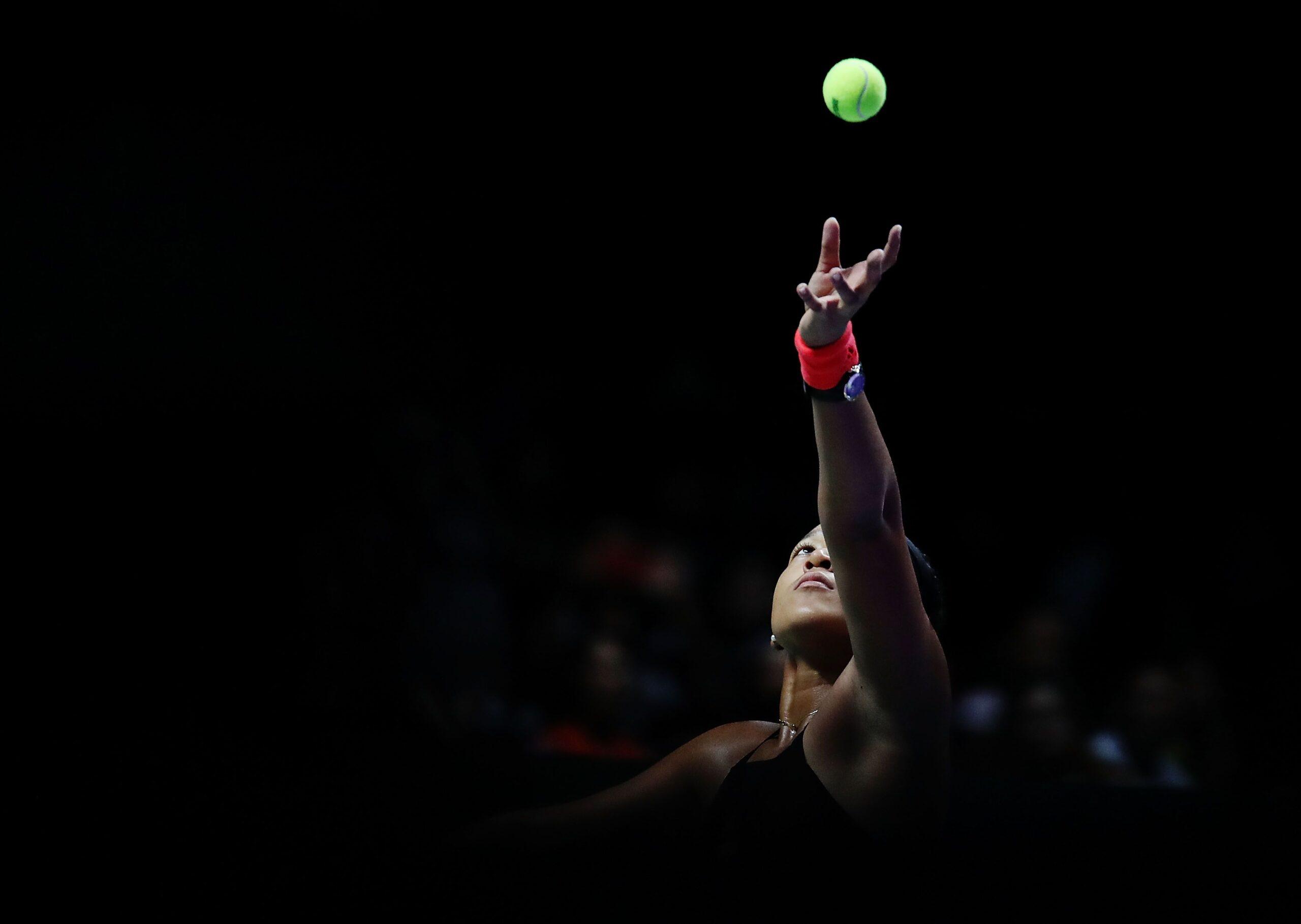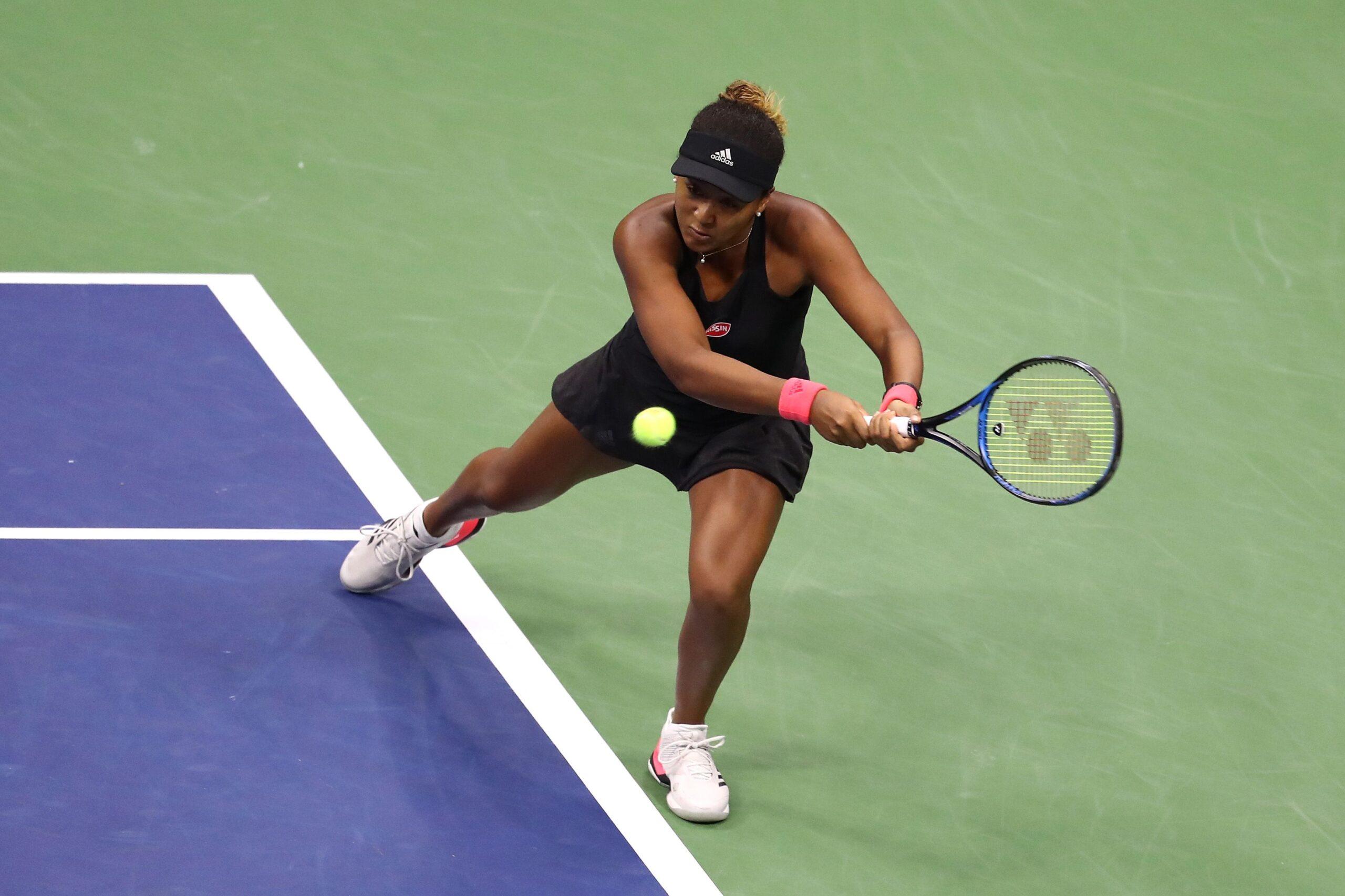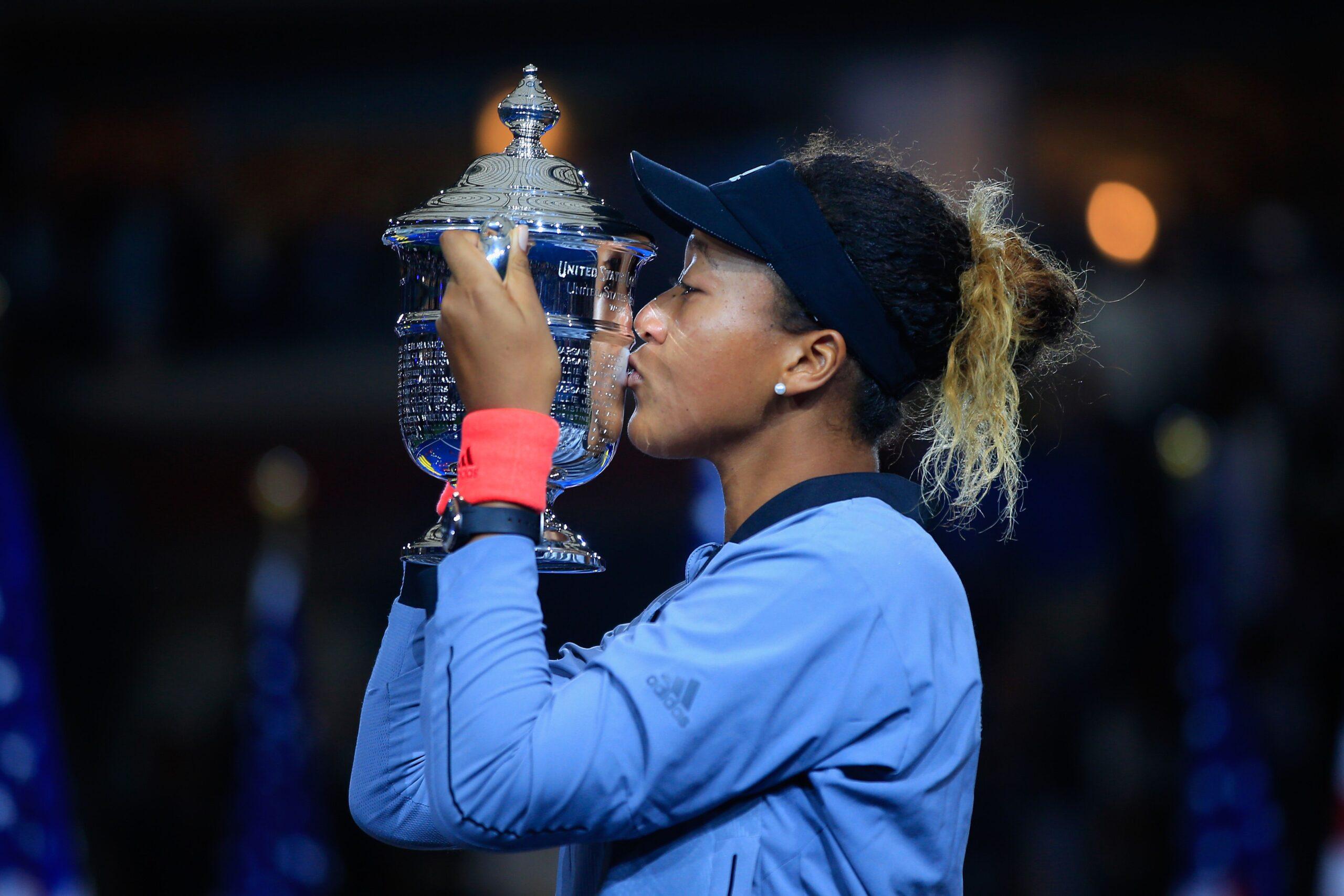Naomi Osaka Is Between Worlds
The 21-year-old was born in Japan and raised in America. She’s the future of tennis and plays like stars past. In a way, she’s different than anyone her sport has ever known. So why does Osaka feel so familiar?In his 1969 book Levels of the Game, author John McPhee leans on one word when describing tennis player Clark Graebner’s serve: crunch. “Graebner’s big frame rocks backward over his right leg, then rocks forward over his left as he lifts the ball for his first serve of the match. Crunch. Ace. Right down the middle at a 130 miles an hour.”
When I imagine crunch, I see Graebner’s knees bent, his left arm reaching toward the sky and his right clutching his steel frame. I see everything locked at tight angles, jaws paused, waiting to snap shut. I hear the metallic clunk that rings out as the serve leaves his racket, the whistling path of the ball as it spikes down the T, the low boom as it hits the back wall. If crunch is a feeling and not a Graebner-only attribute, it has been passed through the years. It’s revealed itself in Boris Becker and Pete Sampras, in Andy Roddick and Lindsay Davenport. Now, you can see crunch in the next generation. It is here in Naomi Osaka.
There is a snap to her game. There is a bite on the end of her strokes. They spark and clang. There is not much need to describe why it is fun to watch power tennis. Crunch is, and always has been, deeply satisfying to watch.
If you spend any time around tennis, you probably know a handful of things about Osaka: Her father is Haitian American and her mother is Japanese. She took part in a dramatic, controversial final at this summer’s U.S. Open that ended with her accepting the winner’s trophy in tears. She is 21 years old and can generate screaming power. Now ranked fifth in the world, she’s become the brightest young hope in an aging game, the promise of a generational star who could take the mantle from the Rogers, Serenas, and Rafas to emerge as tennis’s representative for the culture at large. Osaka is not just the owner of a beautiful game, but the bearer of expectation for a sport and a nation. She’s a representative of the misunderstood.

Osaka was born on October 16, 1997, in, as it so happens, Osaka, a massive city in the center of the Japanese archipelago. Her parents met in the early 1990s in Sapporo, the capital of Hokkaido, Japan’s northern island. Tamaki Osaka, Naomi’s mother, had been sent to Sapporo from her small, homogeneous hometown of Nemuro for high school. It was there that she met Leonard Francois, a Haitian college student who had roots in New York.
The pair dated in secret for years. When Tamaki told her parents that she was planning on marrying a foreigner, she was called a disgrace and didn’t speak with her family for years after. It was in this climate that Naomi and her older sister, Mari, were born.
In 2000, when Naomi was 3, the family moved to Long Island, where Francois’s parents lived. Inspired by watching the Williams sisters on television, Francois decided that his daughters would play tennis too. In 2006 the family moved to Florida, where many American-based tennis professionals and prodigies train, and homeschooled Naomi and Mari at night while training them during the day. As the Osaka daughters left their tweens, Francois decided that they would play under the Japanese flag; while the United States Tennis Association had not been particularly eager in developing them, the Japanese federation did not need convincing.
Since then, Naomi has understandably been between worlds. She’s grown up in the United States the way most American tennis prodigies have, but isn’t in sync with that identity. “I don’t necessarily feel like I’m American,” she told The New York Times in August. “I wouldn’t know what that feels like.”
And though Osaka represents Japan, she is not the typical Japanese athlete. She is still growing comfortable with the language and looks different than the majority of the country’s competitors. Had she represented the United States, there might be less confusion about who Osaka is. Though this country has shown it is far from comfortable with a malleable idea of what it means to look or sound American, the United States has at least proved that it can embrace a superstar athlete who’s the child of a black father and an Asian mother: take the wildly popular face of the other country club sport.
Biracial athletes from Japan, though, have been few and far between. Japanese people who don’t have two Japanese-born parents are sometimes referred as hafu, meaning “half.” Chicago Cubs pitcher Yu Darvish, who’s half-Iranian and half-Japanese, is probably the most high-profile example. While Darvish’s vicious slider and MLB success have granted him fame and praise throughout Japan, many of his biracial compatriots haven’t received the same treatment. In 2015, Ariana Miyamoto, a woman who is half-black and half-Japanese, won Miss Universe Japan. It ignited a firestorm among people enraged that a biracial person would be awarded the honor.
Earlier in Andy Murray’s career, before he won his first Wimbledon, it was often joked that he was British when he won, but Scottish when he lost. For athletes in Japan, there is a similar saying, albeit with a darker edge. “If you win, you’re Japanese. If you lose, you’re a hafu.” In victory, now, Osaka is embraced, but there is work to be done. “Even as a new generation starts to embrace a broader sense of what it means to be Japanese, a conservative strain in the country clings to a pure-blood definition of ethnicity,” Motoko Rich wrote for the Times after the U.S. Open. “Still, the Japanese media warmly welcomed Ms. Osaka’s victory as the country’s own.”
This dissonance, this lack of clarity about what should be, is what draws me most to Osaka.

I have a brown face, brown eyes, and black hair. I have a Portuguese last name. My parents speak with accents that can drift between Indian and other inflections I can’t identify; mine is unmistakably American with some DMV-specific quirks, or so I am told. Sometimes people will approach me speaking Spanish and I’ll do my best to respond with an elementary grasp of the language. Sometimes people will approach me speaking Hindi, and I’ll generally frown and shake my head. Sometimes, though not so much anymore, I’ll be asked if I celebrate various holidays connected with Hindu culture, but associated with India as a whole. I’ll respond that my family is Catholic. My Indian friends sometimes say I’m not really Indian. My non-Indian friends do their best to tread lightly while trying to make sense of exactly what my deal is.
To be honest, I can’t tell you what my deal is. Identity comprises myriad factors: physical traits; linguistic, religious, and culinary traditions; geography; and some undefinable but seemingly ubiquitous sense of belonging. I often find it hard to determine where I fit on the spectrum of Indianness or Catholicness or Americanness, and have just as much trouble parsing whether these things are in some state of conflict. For many communities across the United States, part of identity is a feeling of mutual discomfort, an understanding of one’s own otherness that can bring groups together. I have always been unclear on what makes me like or unlike people around me. I’ve spent so long unsure of whether I fit in or not that I don’t fully know how to distinguish between the two.
Profiling Dwayne Johnson, who is half-black and half-Samoan, for GQ last year, Caity Weaver wrote that the actor’s “uncommon ethnic background means that, in the right light, he can read as Pacific Islander, Latino, Middle Eastern, Native American, Southeast Asian, undead Scorpion King from an ancient civilization, black, white, or any combo thereof. … In other words, pretty much anyone can find themselves, or a slightly tanner or paler version of themselves, in Dwayne Johnson if they look hard enough.” I feel the same way about Osaka.
The first time I saw Osaka play tennis, I did a double take. In the fall of 2016, I was sitting on a couch in Los Angeles and watching the early stages of the U.S. Open when I saw a black woman with orangey hair hitting the living hell out of the ball and cruising through a match on an outer court. Then I heard the announcers refer to her by name, and saw “JPN” on the scoreboard. I was confused. I had never before encountered a multiracial Japanese athlete. I realized that I’d unthinkingly formed an idea of what it meant to “look” Japanese, failing to recognize that this need for categorization was exactly what had grated against me in my own life. I was not alone. When she first appeared on the professional circuit, Osaka told Racquet that she could “see the shock on people’s faces.”
From that point forward, it was easy to root for Osaka. She was funny, charming, and had a divine rapier for a forehand. When she won her first tournament at the so-called fifth slam in Indian Wells, I hoped it would not be a flash in the pan. Then she went on a tear to win the U.S. Open, and in beating Serena Williams—who inspired the Osaka family’s turn toward tennis—the match felt, in a way, like a passing of the torch.
Osaka enters 2019 as the potential face of the next generation of tennis. And her ascendance in the sport isn’t just meaningful because it will help stave off the tour’s aging star problem, but because it could double as a widely broadcasted prompt for a more flexible understanding of identity. “When I look 15 years into the future, I see Naomi having a great tennis career,” Osaka’s agent, Stuart Duguid, told The Times. “But I also hope that she’s changed cultural perceptions of multiracial people in Japan. I hope she’s opened the door for other people to follow, not just in tennis or sports, but for all of society. She can be an ambassador for change.”
“Maybe it’s because they can’t really pinpoint what I am,” Osaka has said, “so it’s like anybody can cheer for me.”

In late September, Osaka made a run to the finals of an indoor tournament in Tokyo. Probably still recovering physically and mentally from her run through the Open draw weeks earlier, she lost the match. Yet in the lead-up to the final, in which she didn’t lose a set, her game shone. Returning the serve of the 6-foot-1 Karolina Pliskova in the first set, Osaka showed all of the tools in her arsenal, moving around the court, blocking back potential winners, then turning defense into offense, touching both lines. Crunch.
“I don’t feel any extra pressure playing in Japan,” she said during the tournament. “I’ve improved a lot of things in the last few years and I feel excited playing here.”
Osaka is only one athlete in her generation to force onlookers to reconsider their expectations. There’s also Rui Hachimura, the Gonzaga forward who’s the son of a Beninese father and a Japanese mother. Last month he torched Zion Williamson and Duke to signal his arrival, and he’s widely projected to become a 2019 NBA lottery pick. As they continue to excel, Hachimura and Osaka could take on exponential importance in Japan; Kei Nishikori, the product of the “Project 45” national initiative to mold a top tennis player, earns more from endorsements than anyone on tour save Roger Federer. Nishikori is a fine player ranked ninth in the world, but his popularity in Japan is outsize; the country is enamored of its stars and hungry for more.
At the start of 2018, Osaka was largely an unknown. By the end of it, she’s begun to feel familiar. She’s between worlds and the center of a changing universe all at once. Identity is what we make it.
